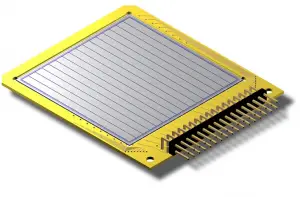
A semiconductor detector is a radiation detector based on a semiconductor, such as silicon or germanium, to measure the effect of incident charged particles or photons. In general, semiconductors are inorganic or organic materials that can control their conduction depending on chemical structure, temperature, illumination, and the presence of dopants. The name semiconductor comes from the fact that these materials have electrical conductivity between a metal, like copper, gold, etc., and an insulator, like glass. They have an energy gap of less than 4eV (about 1eV). In solid-state physics, this energy gap or band gap is an energy range between the valence band and conduction band where electron states are forbidden. In contrast to conductors, semiconductors’ electrons must obtain energy (e.g., from ionizing radiation) to cross the band gap and reach the conduction band.
Principle of Operation of Semiconductor Detectors
The operation of semiconductor detectors is summarized in the following points:
- Ionizing radiation enters the sensitive volume of the detector and interacts with the semiconductor material.
- Particle passing through the detector ionizes the atoms of the semiconductor, producing the electron-hole pairs. The number of electron-hole pairs is proportional to the energy of the radiation to the semiconductor. As a result, many electrons are transferred from the valence band to the conduction band, and an equal number of holes are created in the valence band.
- Under the influence of an electric field, electrons and holes travel to the electrodes, where they result in a pulse that can be measured in an outer circuit,
- This pulse carries information about the energy of the original incident radiation. The number of such pulses per unit time also gives information about the intensity of the radiation.
The energy required to produce electron-hole pairs is very low compared to the energy required to produce paired ions in a gaseous ionization detector. In semiconductor detectors, the statistical variation of the pulse height is smaller, and the energy resolution is higher. As the electrons travel fast, the time resolution is also very good. Compared with gaseous ionization detectors, the density of a semiconductor detector is very high, and charged particles of high energy can give off their energy in a semiconductor of relatively small dimensions.